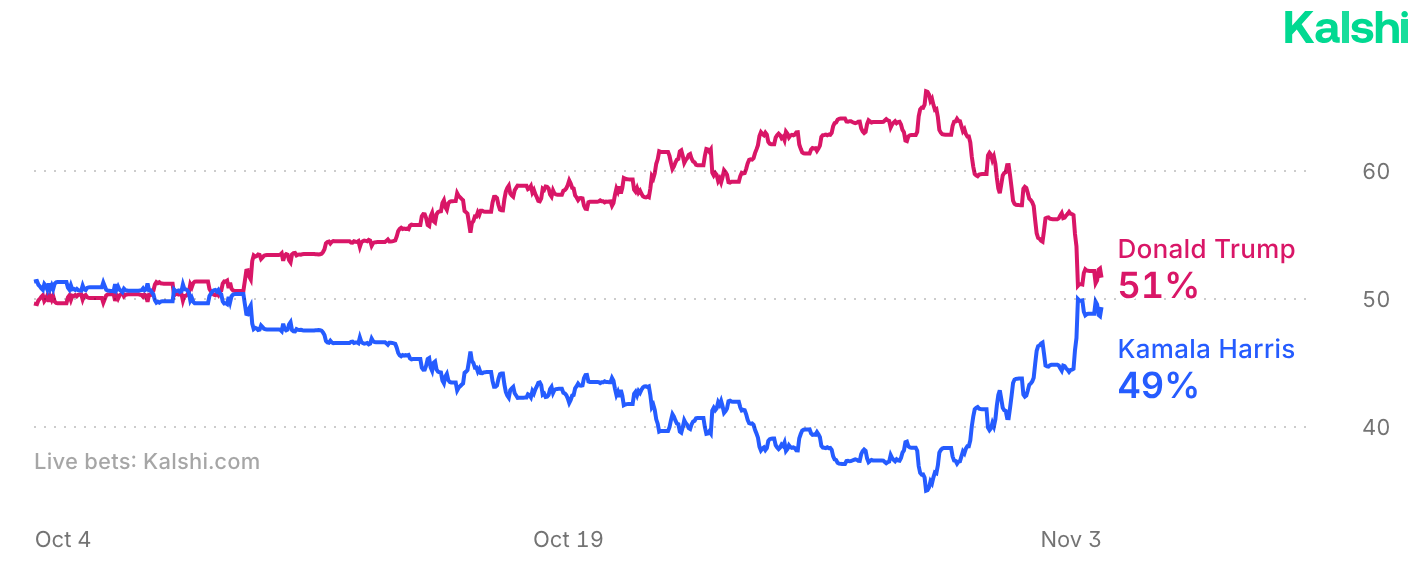Clashing and Collapsing Narratives
In a recent post I observed that the price of a contract in a prediction market, though commonly interpreted as a probability, doesn’t correspond to the belief of any trader. Almost all market participants think that the price is wrong, but they disagree about whether it is too high or too low. Those who consider it too low have already accumulated as many contracts as their tolerance for risk and their budget constraints will permit, and are uninterested in buying more. And those who feel it is too high have already bet against the event and don’t wish to increase their exposure.
The price is thus a point of balance between competing narratives, and it changes as new data (or new entrants) arrive supporting one view or another. Most of the time these effects are incremental, but occasionally a piece of evidence appears that so heavily favors one narrative over the others that a sharp movement in price occurs.
This happened yesterday with the release of a highly anticipated Iowa poll conducted by J. Ann Selzer, whose reputation in polling circles is legendary. The poll found Harris ahead by three points in a state that had not been considered even remotely competitive this year, and to which neither campaign was paying much attention.
In 2016, the final Selzer poll of Iowa found Trump ahead of Clinton by seven points, which took many by surprise at the time. Obama had won the state twice and was the sitting president. The poll was among the first to expose the significant weakness in the Midwest that would end up costing Clinton the election. Trump went on to win Iowa by nine, while toppling the adjacent blue wall.
Similarly, in 2020, the final Selzer poll had Trump ahead of Biden by seven points; he ended up winning the state by eight. As before, this poll suggested weakness in nearby states that other pollsters has failed to pick up. Even though Biden managed to win the election, his margins in the Midwest were much narrower than most had anticipated. The Selzer poll again proved prescient.
As a result, the finding by Selzer that Harris was now ahead in Iowa sent shock waves through social media. The effect on markets was large and immediate. On Kalshi, a race that was leaning quite heavily towards Trump just four days ago is now a toss-up:
Movements on other exchanges were similar in magnitude and direction, though starting and ending at different levels.
Most statistical models based on opinion polls have seen a very tight race for at least a month, and markets have been moving towards these models over the past couple of days. The Selzer poll seems to have given them the final push needed to get there.
So which narrative was boosted by the poll?
It appears that politically independent women are driving a “late shift” towards Harris in the wake of the Dobbs decision. Iowa instituted a ban on abortions (with some exceptions) after roughly six weeks of pregnancy in June of this year, replacing a much less restrictive earlier law. Voters appear to be responding to this in large numbers. This would also explain why Harris is ahead in Nevada among those who have already voted, despite significant Democratic underperformance in the early vote so far.
Other narratives remain alive, of course. The idea that Selzer stacked the deck is simply untenable given her stellar reputation, but supporters of the former president could argue that Iowa’s highly restrictive abortion law makes it a special case with limited general applicability.
The physicist Murray Gell-Mann is reported to have said: “imagine how hard physics would be if electrons could think.” The social sciences are so challenging and absorbing because they deal with complex systems whose component parts have feelings and make decisions. Their subjective beliefs influence their behavior, and this affects the objective likelihood of events about which they hold these beliefs. Thus pessimism can be fatal to a political campaign, just as optimism can end up justifying itself.
The most powerful impact of the Selzer poll is in puncturing the market-driven narrative that Trump was headed for victory, and thus making that very outcome a bit less likely. His supporters recognize this, of course, and are thus keen to cast it as a suppression poll and media lie. But even flawed polls can have real effects by giving rise to self-fulfilling narratives. And this poll is certainly not flawed.


